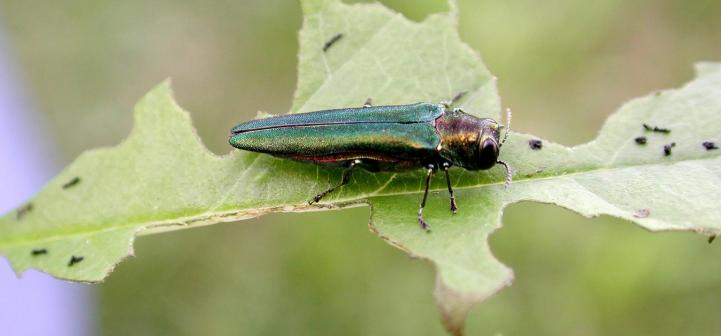Invasive Species: Rosa bracteata, Macartney Rose
Macartney rose is an evergreen, thorny, climbing or trailing shrub that invades open, disturbed areas throughout the Southern United States. Plants often grow in clumps. Stems are arching canes with recurved thorns. The alternate leaves are pinnately compound with serrated margins. Leaflets are 1 to 3 in. (2.5 to 7.6 cm) long. Flowers are white with five petals and occur in small clusters from April to June. Fruit are small, green to red rose hips and are present from July through December. Macartney rose can form dense, impenetrable thickets in open forests and pastures. Infestations restrict use of land by cattle and wildlife and displace native species. Macartney rose is native to Asia and was introduced in the United States as an ornamental plant.
What are invasive species, and why should we be concerned about them?
Taxonomy: Scientific and Common Names for This Species
Rosales > Rosaceae > Rosa bracteata J.C. Wendl.
Rosa bracteata – USDA PLANTS Profile
Distribution Maps
Macartney rose – The reported distribution of this invasive species across the United States (Source: Invasive Plant Atlas of the United States)
Up-to-the-minute distribution maps and why they are important
Reporting This Invasive Species
What is the best way to report the occurrence of an invasive species?
How to report an invasive species sighting to EDDMapS – Early Detection & Distribution Mapping System
EDDMapS – Report an invasive species to EDDMapS.
County Extension Offices – Find your county Extension office on this map provided by USDA.
How to Identify
This invasive species can be identified by looking for the characteristics described in the paragraphs that follow.
Plant
Macartney rose is an evergreen, thorny, climbing or trailing shrub. Plants often grow in clumps. Stems are arching canes with recurved thorns.
 |
 |
| Karan A. Rawlins, University of Georgia, bugwood.org | James H. Miller, USDA Forest Service, bugwood.org |
Foliage
The alternate leaves are pinnately compound with serrated margins. Leaflets are 1 to 3 in. (2.5 to 7.6 cm) long.
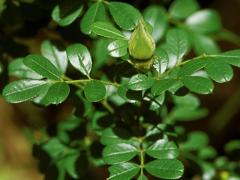 |
 |
| James H. Miller, USDA Forest Service, bugwood.org | Karan A. Rawlins, University of Georgia, bugwood.org |
Flower
Flowers are white with five petals and occur in small clusters from April to June.
 |
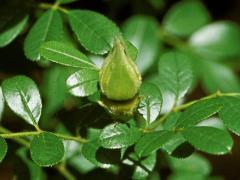 |
| James H. Miller, USDA Forest Service, bugwood.org | James H. Miller, USDA Forest Service, bugwood.org |
Fruit
Fruit are small, green to red rose hips and are present from July through December.
 |
|
| James H. Miller, USDA Forest Service, bugwood.org | bugwood.org |
Native Rose Species Can Resemble Macartney Rose
Rosa woodsii, Wood’s rose – Images at invasive.org
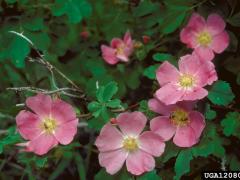 |
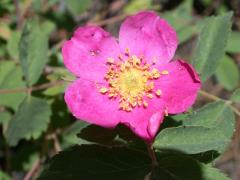 |
| Dave Powell, USDA Forest Service, bugwood.org | Mary Ellen (Mel) Harte, bugwood.org |
Rosa carolina, Carolina rose – Images at invasive.org
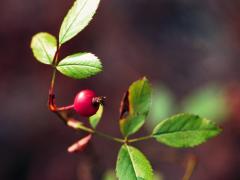 |
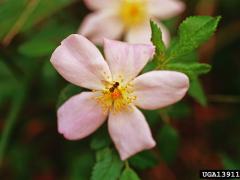 |
| James H. Miller, USDA Forest Service, bugwood.org | John D. Byrd, Mississippi State University, bugwood.org |
Additional Images for Macartney Rose
Macartney rose – Images at invasive.org
Learning Resources for Macartney Rose
Additional Information, Biology, Control and Management Resources
Control and management recommendations vary according to individual circumstances. Location, habitat, weather, and a variety of other conditions are factors that help determine the best treatment choice. To find the safest and most effective treatment for your situation, consult your state’s land-grant institution. If you will use chemicals as part of the control process, always refer to the product label.
United States Land-Grant University System – Find your Land-Grant University’s College of Agriculture, University Cooperative Extension Service, or other related partner on this map provided by USDA.
A Field Guide for the Identification of Invasive Plants in Southern Forests – USDA Forest Service
A Management Guide for Invasive Plants of Southern Forests – USDA Forest Service
Rosa bracteata – Global Invasive Species Database
Invasives Database – Texasinvasives.org
Macartney rose – A Guide to Invasive Species of the Galveston Bay Area
